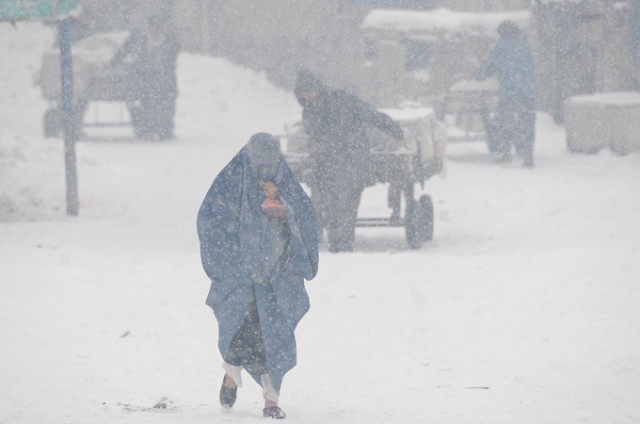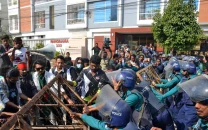More than 100 killed in Afghan avalanches: officials
Acting governor says 95 bodies recovered in Panjshir province north of Kabul and more than 100 homes destroyed

File photo of a woman struggling to make her way through the snow covered streets of Kabul. PHOTO: AFP
Most of the victims were in Panjshir province north of the capital Kabul, where 95 bodies were recovered according to acting governor Abdul Rahman Kabiri.
The avalanches after two days of heavy snow destroyed more than 100 homes in the province and blocked main roads, making it difficult for rescue workers to reach the stricken villages.
Read: Left stranded: Snowfall halts traffic at Lowari Tunnel
"Ordinary people and government employees are using shovels and bare hands to rescue those who are still trapped under the snow," Kabiri said.
The death toll could rise unless the central government and relief organisations sent emergency assistance soon, he warned.
Twenty-nine people were suffering from frostbite and other injuries, the acting governor said.
Read: Grey skies ahead: Strong weather to stir up thunder, hailstorms in K-P
The toll was confirmed by Abdul Rahman Kalantari, head of disaster response at the Afghan Red Crescent Society, who said they had already dispatched health teams to Panjshir.
A further 11 people were killed in the provinces of Bamyan, Badghis, Nangarhar and Laghman, officials said.
Deadly avalanches are common in Afghanistan's mountainous areas in winter. One in the remote far northeast in 2012 left 145 people missing, presumed dead.
Read: Stranded: Snowfall halts traffic on Lowari Tunnel
The country has had a largely mild and dry winter, but large parts of the north experienced heavy snowfall over the last 48 hours.
Parts of the capital Kabul were hit by power cuts on Tuesday and Wednesday after snowstorms and avalanches damaged power cables in the Salang Pass, which links the city to the country's north.
The pass remained closed to traffic on Wednesday.
Read: Too cold for comfort: Wana’s residents left with little to keep warm
Despite the billions of dollars in aid from the international community after the collapse of the Taliban in 2001, Afghanistan remains among the world's poorest nations after decades of conflict.
Rescue efforts after disasters such as avalanches and flash floods, which often hit as snows melt in the spring, are frequently hampered by lack of equipment.
Poor infrastructure makes it difficult for rescue teams to reach isolated areas.



















COMMENTS
Comments are moderated and generally will be posted if they are on-topic and not abusive.
For more information, please see our Comments FAQ